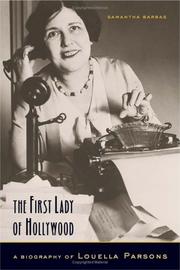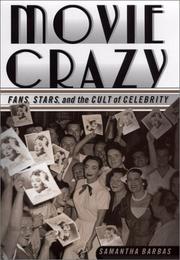| Listing 1 - 4 of 4 |
Sort by
|
Book
ISBN: 0804796718 9780804796712 9780804791441 0804791449 Year: 2015 Publisher: Stanford, California
Abstract | Keywords | Export | Availability | Bookmark
 Loading...
Loading...Choose an application
- Reference Manager
- EndNote
- RefWorks (Direct export to RefWorks)
Americans have long been obsessed with their images—their looks, public personas, and the impressions they make. This preoccupation has left its mark on the law. The twentieth century saw the creation of laws that protect your right to control your public image, to defend your image, and to feel good about your image and public presentation of self. These include the legal actions against invasion of privacy, libel, and intentional infliction of emotional distress. With these laws came the phenomenon of "personal image litigation"—individuals suing to vindicate their image rights. Laws of Image tells the story of how Americans came to use the law to protect and manage their images, feelings, and reputations. In this social, cultural, and legal history, Samantha Barbas ties the development of personal image law to the self-consciousness and image-consciousness that has become endemic in our media-saturated culture of celebrity and consumerism, where people see their identities as intertwined with their public images. The laws of image are the expression of a people who have become so publicity-conscious and self-focused that they believe they have a right to control their images—to manage and spin them like actors, politicians, and rock stars.
Privacy, Right of --- Personality (Law) --- Libel and slander --- Publicity (Law) --- Law --- Calumny --- Defamation --- Slander --- Torts --- Invasion of privacy --- Right of privacy --- Civil rights --- Press law --- Computer crimes --- Confidential communications --- Data protection --- Right to be forgotten --- Secrecy --- History. --- Law and legislation
Book
ISBN: 1503600831 9781503600836 9780804797108 0804797102 Year: 2017 Publisher: Stanford, California
Abstract | Keywords | Export | Availability | Bookmark
 Loading...
Loading...Choose an application
- Reference Manager
- EndNote
- RefWorks (Direct export to RefWorks)
In 1952, the Hill family was held hostage by escaped convicts in their suburban Pennsylvania home. The family of seven was trapped for nineteen hours by three fugitives who treated them politely, took their clothes and car, and left them unharmed. The Hills quickly became the subject of international media coverage. Public interest eventually died out, and the Hills went back to their ordinary, obscure lives. Until, a few years later, the Hills were once again unwillingly thrust into the spotlight by the media—with a best-selling novel loosely based on their ordeal, a play, a big-budget Hollywood adaptation starring Humphrey Bogart, and an article in Life magazine. Newsworthy is the story of their story, the media firestorm that ensued, and their legal fight to end unwanted, embarrassing, distorted public exposure that ended in personal tragedy. This story led to an important 1967 Supreme Court decision—Time, Inc. v. Hill—that still influences our approach to privacy and freedom of the press. Newsworthy draws on personal interviews, unexplored legal records, and archival material, including the papers and correspondence of Richard Nixon (who, prior to his presidency, was a Wall Street lawyer and argued the Hill family's case before the Supreme Court), Leonard Garment, Joseph Hayes, Earl Warren, Hugo Black, William Douglas, and Abe Fortas. Samantha Barbas explores the legal, cultural, and political wars waged around this seminal privacy and First Amendment case. This is a story of how American law and culture struggled to define and reconcile the right of privacy and the rights of the press at a critical point in history—when the news media were at the peak of their authority and when cultural and political exigencies pushed free expression rights to the forefront of social debate. Newsworthy weaves together a fascinating account of the rise of big media in America and the public's complex, ongoing love-hate affair with the press.
Privacy, Right of --- Freedom of the press --- Hill, James, --- Time, inc. --- Time Warner, Inc. --- Time Incorporated --- Time, Inc. v. Hill, 385 U.S. 374 (1967)

ISBN: 9780520940246 0520940245 1423717325 9781423717324 1598755870 9781598755879 9780520242135 0520242130 1282358715 9781282358713 9786612358715 0520249852 Year: 2005 Publisher: Berkeley : University of California Press,
Abstract | Keywords | Export | Availability | Bookmark
 Loading...
Loading...Choose an application
- Reference Manager
- EndNote
- RefWorks (Direct export to RefWorks)
Hollywood celebrities feared her. William Randolph Hearst adored her. Between 1915 and 1960, Louella Parsons was America's premier movie gossip columnist and in her heyday commanded a following of more than forty million readers. This first full-length biography of Parsons tells the story of her reign over Hollywood during the studio era, her lifelong alliance with her employer, William Randolph Hearst, and her complex and turbulent relationships with such noted stars, directors, and studio executives as Orson Welles, Joan Crawford, Louis B. Mayer, Ronald Reagan, and Frank Sinatra-as well as her rival columnists Hedda Hopper and Walter Winchell. Loved by fans for her "just folks," small-town image, Parsons became notorious within the film industry for her involvement in the suppression of the 1941 film Citizen Kane and her use of blackmail in the service of Hearst's political and personal agendas. As she traces Parsons's life and career, Samantha Barbas situates Parsons's experiences in the broader trajectory of Hollywood history, charting the rise of the star system and the complex interactions of publicity, journalism, and movie-making. Engagingly written and thoroughly researched, The First Lady of Hollywood is both an engrossing chronicle of one of the most powerful women in American journalism and film and a penetrating analysis of celebrity culture and Hollywood power politics.
Gossip columnists --- Journalists --- Parsons, Louella O. --- american journalism. --- american movie columnist. --- american screenwriter. --- blackmail. --- celebrity culture. --- citizen kane. --- film industry. --- film journalism. --- frank sinatra. --- hedda hopper. --- hollywood history. --- hollywood power politics. --- hollywood. --- joan crawford. --- louella parsons. --- louella rose oettinger. --- louis b mayer. --- marion davies. --- movie gossip columnist. --- orson welles. --- queen of hollywood gossip. --- ronald reagan. --- studio era. --- the first lady of hollywood. --- walter winchell. --- william randolph hearst.

ISBN: 0312239629 Year: 2001 Publisher: New York (N.Y.): Palgrave
Abstract | Keywords | Export | Availability | Bookmark
 Loading...
Loading...Choose an application
- Reference Manager
- EndNote
- RefWorks (Direct export to RefWorks)
| Listing 1 - 4 of 4 |
Sort by
|

 Search
Search Feedback
Feedback About UniCat
About UniCat  Help
Help News
News